#Jeeter Lester
Text
Canonically disabled characters in podcasts cause I feel like it
- Juno Steel - The Penumbra Podcast (visually impaired)
- Rudyard Funn - Wooden Overcoats (technically not canon but basically has every symptom of autism)
- Arthur Lester - Malevolent (visually impaired)
- Brain Jeeter - The Strange Case Of Starship Iris ( has a disability that gives him trouble breathing though I don't remember if they specify exactly what)
- Lucille Kensington - Where The Stars Fell (I believe chronic pain though I admit I haven't listened to the show. She uses a cane)
- Nicholas Waters - Archive 81 (chronic pain. He uses a cane)
- Sydney Sargent - Camp Here And There (psychosis, autism and chronic pain)
(extra fun fact all these characters are canonically queer accept Arthur though ppl are still holding out hope for him)
#no one come at me for not adding marc and vespa I've heard multiple times that they are not good disability rep#the penumbra podcast#tpp#juno steel#wooden overcoats#wo#rudayrd funn#malevolent#arthur lester#the strange case of starship iris#tscosi#brian jeeter#where the stars fell#wtsf#lucille kensington#archive 81#a81#nicholas waters#camp here and there#chnt#sydney sargent
342 notes
·
View notes
Text
TOBACCO ROAD
1937

Tobacco Road is a play by Jack Kirkland first performed in 1933, based on the 1932 novel of the same name by Erskine Caldwell. The play ran on Broadway for a total of 3,182 performances, becoming the longest-running play in history at the time. It is second only to Life With Father as the longest running non-musical play in Broadway history. Tobacco Road opened at the Theatre Masque (now the John Golden Theatre), transferred to the 48th Street Theatre (demolished in 1955), and then moved to the Forrest Theatre (now the Eugene O'Neill Theatre). It was revived three times on Broadway. Due to its tremendous popularity, it spawned several tours, regional productions, and a film - all while still running on Broadway.
The play is a gritty, often shocking (for the time) portrayal of a poor Georgia family of sharecroppers. It is set in rural Georgia, several miles outside Augusta during the worst years of the Great Depression.
Tobacco Road’s easy-to-tour scenic requirements were described as this: The old dull gray shack was set up to one side, its porch roof crazily careening; the bucket well to the other, and the dilapidated fence between marking a tobacco road in the back country of Georgia.

Taylor Holmes (Jeeter Lester) was born in Newark NJ in 1878. He made his Broadway debut in 1900 in the controversial play Sapho, which was closed down for immorality after 29 performances. In the April 1900 trial, the play was ruled not obscene, and it reopened and ran for an additional 55 performances. He went on to appear in more than 35 Broadway plays, the last in 1946. He also appeared in scores of films (silent and sound) and television shows. His last screen work was providing the voice of King Stefan in Disney’s Sleeping Beauty (1959). He died at age 81, while Sleeping Beauty was still in theatres.
“In order to secure the services of Mr. Holmes for this role. Sam H. Grisman and Jack Kirkland, the producers of ‘Tobacco Road', were compelled to carry on lengthy negotiations with one of the largest motion picture concerns who had him under contract for his temporary release. Mr. Holmes will resume his picture work at the end of his present coast-to-coast trip with ‘Tobacco Road’.” ~ Paterson News, January 23, 1937

Sharing the stage with Holmes were Florence Gerald as Ada Lester, William Bishop as Lov Bensey, Pitt Herbert as Dude Lester, Meryl Boyden as Ellie May, Lillian Ardell as Grandma Lester, Dick Lee as Henry Peabody, and Sally Sanderson as Pearl.

In January 1937, producers Sam H. Grisman and Jack Kirkland brought this production of Tobacco Road to Atlantic City’s The Earle Theatre, a venue primarily devoted to cinematic presentations.

The Earle in Atlantic City opened in October 1926 on at Atlantic and Missouri Avenues. Today, the theatre is long gone and this is the end point of the Atlantic City Expressway. The Earle was owned and operated by the Stanley Company, who also ran the nearby Stanley Theatre on the Boardwalk (later renamed the Roxy), as well as the more famous Earle Theatre in nearby Philadelphia. In fact, there were Earle theatres in several cities in Pennsy, Delaware, and elsewhere. All were primarily dedicated to cinema, with occasional forays into vaudeville, burlesque and (rarely) - as in the case of Tobacco Road - legit.

The production also played other New Jersey venues. Montclair...

Englewood, another affluent bedroom community of the Big Apple...

Asbury Park, at a venue later (and still) known as the Paramount Theatre...

and Holmes’ birth city, Newark, where it was at the Shubert. At the same time, at the Garden Theatre in Patterson, Taylor Holmes’ son Phillips was appearing on screen in a double feature. Ironically, the other film on the bill was titled “Everybody’s Old Man”. Even odder still, Phillips’ “old man” was not even mentioned in the Shubert ad, which was located only a few columns away of the April 18, 1936 Morning Call.
The Shubert in Newark was grand, perhaps too grand for Tobacco Road. For much of the tour the show tried to keep to theme (and budget) by playing lower-rent, less ornate venues, in many case movie and burlesque houses.

This was also the third time many of these stops saw Tobacco, some of which saw the original cast, and then a Road tour. It was difficult for some critics not to compare Holmes with the original Jeeter, Henry Hull, who by then was starring in his second post-Road play. In 1937, the Main Stem’s Jeeter was James Barton, who had inherited the overalls from Will Geer (later TV’s Grandpa Walton) and would eventually fill Holmes’ shoes in the tour.

Finding a theatre in Chicago was difficult since the Mayor had banned the play two years earlier calling it indecent. This must have been busines as usual for Holmes. His first Broadway outing, Sapho, was similarly tagged.

The same happened in Omaha, where the Mayor also banned the play.

Producers shot back a telegram to the local press.

But Omaha theatre-goers did not see Tobacco Road that night. Hearings were held the next day, at which Holmes appeared. He had added incentive to go before the Judge, who, the day before, had borrowed his fountain pen and forgotten to return it! Curiously, when the show played Boston, a city known for the expression ‘Banned in Boston’, there was barely a raised eyebrow.

Holmes started his tour of Tobacco in August 1936, and by May 1937, he had eaten more than 350 turnips, Jeeter’s snack of choice.

Since so many venues were also cinemas, the ads generally stipulated that this was NOT A MOTION PICTURE. Compounding the confusion was that Holmes’ name previously graced many marquees in his screen roles - and his son’s films were playing nationwide during the tour.

The same tactic at the Orpheum in Reading PA. Film buffs beware: No screen attraction today.

In Philadelphia, the Locust Theatre went out of their way to let the public know that this was NOT A WPA ATTRACTION. The Works Progress Administration (WPA) was a New Deal agency, employing millions of jobseekers to carry out public works projects. In one of its most famous programs, the WPA employed musicians, artists, writers, actors and directors in the Federal Theatre Project (FTP). The resulting productions were generally free of charge to the public. This ad is to warn patrons that admission WILL BE CHARGED!

Tobacco gave the Shamokin PA something to crow about: the first big road show in ten years!

In Muncie IN, during April 1937, Holmes was reunited with his film star son, Phillips Holmes. Five years later, Phillips died in a mid-air collision over Canada. His father was bereft.

Holmes’ tour did make some concessions for small town America - notably replacing some of the cursing with more congenial language. Gosh!

While the tour was in Pittsburgh, it shared column space with this item about a possible musical version by Gershwin. As history knows, this idea came to naught. It may have even been an invented story to keep Taylor’s tour in the press.

In July 1937, the Garden Pier in Atlantic City re-opened with a new production of Tobacco Road, then still wowing Broadway audiences. It was fitting that the newly refurbished pier would re-open with a Broadway hit since it had incubated so many shows in its past. Although the national tour continued, Holmes withdrew to have surgery. By November 1937 he was back on Broadway in a new show, the stress of touring behind him.

In 1954, Tobacco Road returned to Atlantic City in yet another production, this time a pre-summer stock week at the Quarterdeck Theatre in residence at the Hotel Morton. For more about that, just click here!

#Tobacco Road#Atlantic City#Taylor Holmes#Jeeter Lester#Broadway#Broadway play#Theatre#Stage#National Tour#1937#New Jersey#Newark#Asbury Park
0 notes
Photo
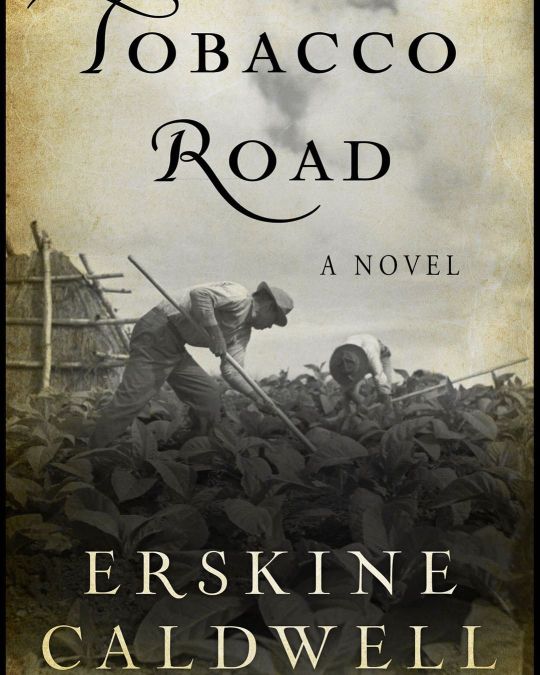
After having read Deep South by Paul Theroux last year, I made a note to read the 1932 novel Tobacco Road by Erskine Caldwell about Jeeter Lester and his farm and family. I just finished it today and my, what a depressing and dysfunctional life those people had in rural Georgia during the Depression. The fact that they were unable to do anything about it makes it even more hopeless. I’m glad I read the book and very happy and blessed to have been born in another time and place. #erskinecaldwell #tobaccoroad #paultheroux #deepsouth (at Upper East Side) https://www.instagram.com/p/Ce_uQmPJeO5/?igshid=NGJjMDIxMWI=
0 notes
Text
ROGER BLOOMER
March 1, 1923

Roger Bloomer is a three-act play by John Howard Lawson (Broadway debut). It was produced by the Equity Players Inc. It opened on March 1, 1923 at the 48th Street Theatre and ran for 50 performances. After Broadway, it transferred to the Greenwich Village Theatre, a production which Lawson considered far superior to the first. This play is considered a prime example of American expressionism.
Roger Bloomer is set in Excelsior, Iowa, and New York City over 30 cinematic scenes. There are 26 characters.
Synopsis ~ The eponymous lead character runs away from his prosperous Iowa home to New York after failing his college examinations. He falls in love with a woman accused of theft at a place where she works—and she commits suicide. He is arrested for murder, and his father hurries to the big city to rescue him. The parallels to Lawson’s own life—moving to New York, suicide, the protective father—are evident.

The printed script contains a politically-charged forward by novelist John Dos Passos, who at the time was about to publish his third novel. Dos Passos’ legacy is the USA Trilogy published in 1938. Dos Passos was a friend and fan of Lawson and was sure he would turn out to be one of the nation’s greatest playwrights.

The printed script also contains renderings for each of the three acts (likely influenced by the set design) by Roland Young.
AUTHOR

John Howard Lawson (1894-1977) was a writer specializing in plays and screenplays. He was the first president of the Writers Guild of America West. For several years he was head of the Hollywood division of the Communist Party USA. Lawson was one of the Hollywood Ten, the first group of American film industry professionals to be blacklisted by Congress during the 1950s McCarthy Era. He and his colleagues refused to testify; he was convicted of contempt of Congress and served a year in prison. This was the first of his nine Broadway plays.
“John Howard Lawson began to write ‘Roger Bloomer’ in France in the fall of 1917, when he was about 23 years old. The play was produced in New York in the spring of 1923, when Lawson was not quite 29. This production brought Lawson to the attention of the New York theatre world. Probably still unrecognized as such, Roger Bloomer is a classic of the modern American theatre-classic in its universality. The first published description of the second act of an early version of Roger Bloomer [was] completed sometime in 1920. The rest of the 1920 version is in general very similar to the 1923 version, but this second act is almost entirely different, and three of its main characters do not appear in Lawson's stage version.” ~ Le Roy Robinson, Nagasaki University
CAST

Henry Hull (1890-1977) as Roger Bloomer. He made his Broadway debut in 1911. On stage, Hull is best known creating the role of Jeeter Lester in the long-running play Tobacco Road (1933). The year before Roger Bloomer, Hull wrote a play titled Manhattan that ran for 86 performances. In Hollywood he played roles in High Sierra (1941) and Lifeboat (1944). He played the title role in Werewolf of London (1935), the first werewolf movie ever made. He was brother-in-law to actress Josephine Hull.

Louis Calhern (1895-1956) as Eugene Poppin. Calhern made his Broadway debut with Roger Bloomer. His most notable stage role also turned out to earn him an Oscar nomination: Oliver Wendell Holmes in The Magnificent Yankee (1946 stage, 1950 screen). In 1950 he replaced Frank Morgan as Buffalo Bill, when Morgan died of a heart attack while filming Annie Get Your Gun (1950).

48th Street Theatre (157 West 48th Street; 970 seats) was built by producer William A. Brady in 1912. In the 1920s, Actors' Equity leased the space for its Equity Players, producers of Roger Bloomer. Renamed the Windsor in 1937 and leased to Labor Stage (the culture wing of the International Ladies Garment Workers Union). It reverted back to its original name in 1943 to avoid confusion with a similarly named theatre in the Bronx. On August 24, 1955, a water tower collapsed and destroyed the theatre. The owners opted to sell the land rather than repair the damage.
The most successful play in the theatre's history was Harvey (1944) by Mary Chase which ran for 1775 performances, won Chase the Pulitzer Prize for Drama, and was adapted into a 1950 film. Another success at the theatre was Stalag 17 (1951), which was also made into a successful 1953 film.
#Roger Bloomer#Broadway#1923#48th Street Theatre#Henry Hull#John Howard Lawson#Hollywood Ten#John Dos Passos
0 notes
Photo

Book Review: “Tobacco Road” Erskine Caldwell 1932
The book I’m reviewing is “Tobacco Road” by Erskine Caldwell. This is a book published in 1932. I find it a delight to read books that are so far separated from my own decade and generation. It is undeniably the most effective and accurate time machine ever discovered.
As an avid bookworm I am always reading, consuming literature because it’s the lifeblood of my soul and food for the animal that is my creativity. Some books I chose because I know a little about them and they pique my interest, others I pick at random, or because they have beautiful covers, or covers that tell me nothing at all and I have to know! That is how I chose this book, the name sounding interesting and the book was beautiful.
To begin while time set is never directly mentioned a little research tells me the story is set in the Depression Era. The story focuses on three households, Jeeter Lester, Lov Bensey(married to Jeeter’s youngest daughter) and Bessie the widowed preacher woman. I found each and every character to be deplorable types without redeeming quality. At best some were merely stupid and lazy or deluded.
Next we move to the plot....there is none. It is a story without a story, just a dance of character interactions that was highly circular with no real direction. In all cases conversations were more like monologues that occasionally overlapped and only have 3 or 4 thoughts to be said and then reaching the last thought they would jump back to the first and repeat. Eventually the book simply ends with a fairly clean finish for a book with no plot.
This book is surprisingly well written for a story with no plot or purpose. The events that occur in this story amount to a level of ridiculous(my sister laughed to tears when told the summary) that I am left to believe it was written to make a point or commentary on current culture or circumstance using extreme exaggeration as the primary tool, but being neither from the 30′s nor possessing intimate details of the author or his design for the book, I cannot make a conclusion on the point.
My final thoughts are that I strangely enjoyed it and I think because it is so drastically different from the fiction available now,the change was refreshing. It's certainly not for the qualities of the story, although I think the writing was actually skilled. Every character is exactly what they're intended. I learned a few new words like Pellagra and lilliputian but I will warn you that this book is STEEPED in racism and bigotry. The women are at best treated like servants and the people of color are treated worse. If you are sensitive to this then pass on by!
For an In-Depth review scroll below.
SPOILERS! SPOILERS! SPOILERS! SPOILERS! SPOILERS!
Our characters are from 3 households, the main, and largest is Jeeter Lester, husband of Ada Lester, she has had 17 children. Two children remain in the home, Dude Lester, age 16, and Ellie May, about age 18-19 who is considered beautiful except for her face which has a hair lip/slit lip, and the Grandmother Lester.
Next is Lov Bensy and his wife Pearl, the 12 year old daughter of Jeeter Lester. They have been married about a year so she is nearing 13 at the time of the story.
Our last character is Sister Bessie, the 39-ish widowed preacher woman(late husband was also a preacher) but she comes across to me more like a split off of a Christian religion that we would define more of a cult, nothing directly stated but she definitely seemed ‘off’ on her religion to me.
The story begins with Lov carrying home a sack of turnips he bought for 50 cents and reluctantly going by the Lester home, which he normally takes a long circuitous route to avoid because they’re mean, so he can get advice regarding Pearl’s refusal to sleep in the bed with him or have sex with him. He hopes to get Jeeter’s opinion on him trying to tie her to the bed. He arrives at the house but waits on the road(Tobacco Road) unwilling to go on the property at first fearing they'll steal his turnips. He eventually goes on the property and he talks about his problems with Pearl and Jeeter interrogates him about what's in the sack, are they turnips in the sack, all his turnips he tries to grow have green worms in them, his turnips don't have green worms do they, and occasionally snapping at Dude for throwing a baseball against the house and if he keeps at it the house will just fall down.
Stop story and circle conversation 3 times
.
Resume story with Ellie May creeping in from the outskirts of the yard, dragging her bare butt on the ground like a dog and making overt sexual advances towards Lov. Jeeter and Lov continue circular conversation but Lov is distracted and staring at Ellie May.
Interject awkward commentary and questions by Dude towards Ellie May's advances and if she and Lov are going to get it on right there. Entire family just watching the whole thing along with a group of black men on the road. Lov eventually becomes distracted enough by Ellie that he leaves the turnip sack and Jeeter dives for it, a brawl ensues but Jeeter escapes with the turnips. Lov leaves in defeat and doesn't return for many many chapters.
Here we pause the progression of the story to learn about how the family fell into poverty how they were all starving to death because they only had black jack wood to grow and it wasn't good for anything so they could hardly sell it and for very little and how no one would give him credit so he couldn't buy supplies to plant cotton. There are many reasons and excuses but all imply a combination of hard times and Jeeter's overall laziness, constantly putting things off until tomorrow and refusing to work in the mills prefering to stay on the land and starve. We learn that they're refusing the Grandmother(often referred to as a doorstop even by herself) food except for the rare crumbs and scraps that even they won't eat because they feel she's lived too long already and are trying to hurry her along to death. Later we learn Jeeter is trying this with his wife Ada as well, preventing her from eating when he can but she's finding edible flowers and grass and such so despite her disease Pellagra(nicotene defficiancy) which slowly wastes her away she still just won't die. We're told about Jeeter's theft/remorse cycle that will never end despite his saying he'll change every time and then we circle that conversation a few times then he returns with Dude(whom went out to find him before the turnips were all eaten) and the turnips get dispersed to the rest of the family.
Along comes Sister Bessie. She preaches at them about their sins, explains that God gave Ellie may the slit lip because without it she would have been really pretty and Jeeter would have slept with her so it protected her from him. Jeeter eventually agrees. They circle this conversation many times and eventually she kneels them all down to pray away their sins and eventually prays with just Dude(whom she totally left out the first time) and they end up just on the porch hugging and rubbing each other which leads us into her declaration that she's considering marrying Dude but she's ask God and decide tomorrow. She returns in the morning declaring God said to marry Dude and make him a preacher. She announces she's going to town with Dude, they're going to buy a brand new car then get a marriage license. Dude agrees to all because he wants the car and spends the rest of the story driving the car and honking it's horn.
Returning from the city with their marriage license Dude and Bessie hit and run a wagon off the road, crunching and tearing off the car bumper, killing the man driving it, but he was a black man so they decide it doesnt matter, it was his fault and just leave him there. Jeeter convinces them to let him use the car to deliver wood to the town so they load it up and the wood tears holes in the seats and Dude hits a stump and seriously dents the other bumper. Dude driving(only he is allowed to drive the car) and Jeeter and Bessie go to town again to sell the wood but fail. They burn up parts of the car engine cause they've been driving it all this time without oil in it so it's running but ruined. They sell the spare tire and buy a small bit of food then return home, crash the car again on the way smashing the side this time. The next day Jeeter again wants to go to town but Bessie decides she doesn't want him near her car again cause he's bad for it so she and Dude try to make a run for it in the car. A brawl breaks out, Dude in the car the whole time and then Bessie makes it to the car. They take off, escaping, but they run over the Grandmother as they go. She doesn't die immediately but everyone decides to just leave her in the road unconcerned.
Lov returns at this time to announce that Pearl has run away from him, probably to the big city near them but it's never declared for sure. He idly asks what's the matter with the Grandmother and then they go on to loosely bargain Ellie May returning home with him to cook his dinners for that night but it's loosely implied he should just keep her to replace Pearl. He helps Jeeter bury the Grandmother though they don't say for sure if she's actually dead yet. Jeeter then decides to finally(he's put it off for the whole book) burn the scrub brush off his fields that he can't plow or plant just in case he randomly can all of a sudden and then he goes to bed. The brush fire catches the house on fire and Jeeter and Ada die inside of it. Lov and Dude and Bessie return with some random town folk to remove the bodies and bury them and then the story ends.
0 notes
Text
THE OTHER ROSE
1923
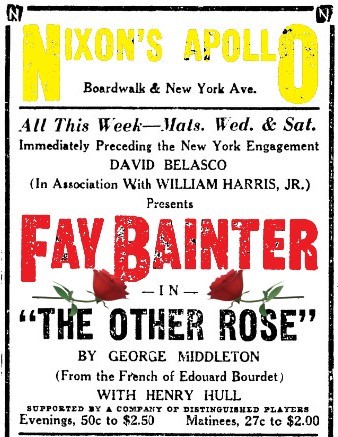
The Other Rose is a play by George Middleton based on a French play by Edouard Bourdet. It was originally produced and directed by David Belasco, in association with William Harris Jr. It starred Fay Bainter as Rose Coe. Henry Hull was featured as Tony Mason.
Playwright Middleton was a ‘Jersey Boy’, born in Paterson NJ in 1880.
The play takes place at a cottage in Whale Harbor, Maine.
Rose Coe, the 28 year-old daughter of a prematurely aged scientist, rents a cottage in Maine for herself, her father Professor Andrew Coe, and her 12 year-old brother Johnny, only to discover that Tony, the young son of the landlady did not intend it to be rented. It was, he said, a love shrine, where he had met the passion of his life the previous season; "the other Rose." He tries to put the new tenants out, with the unexpected consequences; love.”
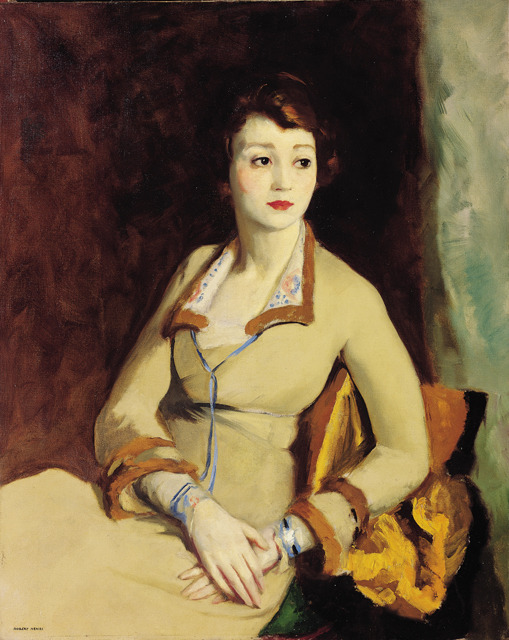
Fay Bainter (1892-1968) started acting on Broadway in 1912. This was the 8th of her 25 Broadway appearances. In Hollywood, she won an Academy Award for Jezebel (1938).
"I don't think I have ever been as happy in a part as I am in playing Rose Coe. It is a real pleasure to play a modern American girl of such high ideals and one who is so essentially human in every respect. I regard Rose as a girl I would be very glad to know in real life. She is the sort I would like to have come and stay with me and I feel that her friendship would be distinctly worth while. There Is no affectation or pretense about Rose. She is sincere and honest and I try to play her in a natural, straightforward manner. My interest in her is unusually keen and I approach every performance with the desire to give my best that the audience may know and love her as I do. It is really delightful to be playing in such a charming romance as 'The Other Rose.'"

Henry Hull (1890-1977) was ‘born in a trunk’ to a theatrical family. His father was once a press agent for David Belasco. In 1933, Hull created the role of Jeeter Lester in the long-running play Tobacco Road. He had started acting on Broadway at age 21. This was his 12th Rialto appearance.
Rehearsals began on November 5th at the Belasco Theatre in NYC. This was Bainter’s first collaboration with Belasco.
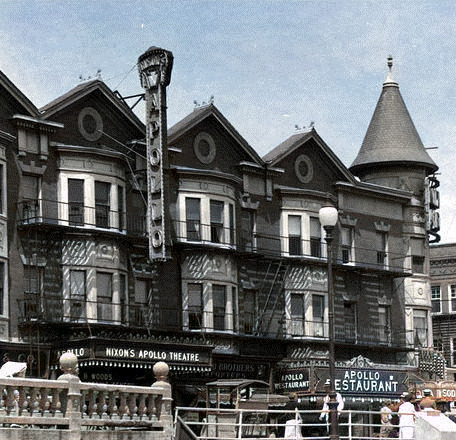
The Other Rose opened at Nixon’s Apollo Theatre in Atlantic City on December 3, 1923. After AC, the play traveled to DC, holding forth at the National.
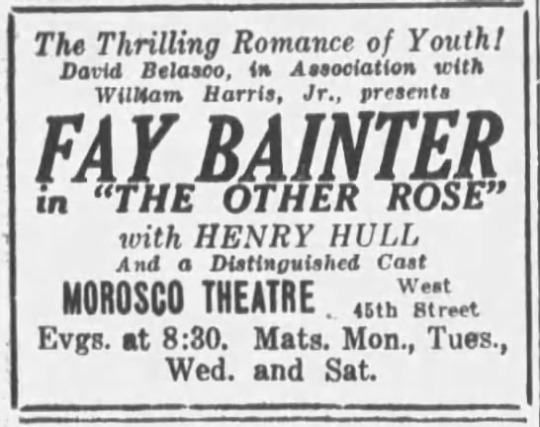
The Other Rose opened on Broadway at the Morosco Theatre on December 20, 1923.
ABOUT THE VENUE: The Morosco Theatre (217 West 45th Street) was built in 1917 and named for theatre manager Oliver Morosco. In 1982, despite protests, it was razed to make way for the Marriott hotel.
"’The Other Rose' is an obvious play but it is a sweet play nevertheless. In this day of stark, forthright realism, one should be thankful for a sweet play. Perhaps, if you are a bit old-fashioned, you will wish that there were more of them. I do.” ~ BRETT PAGE

“There are no surprises and no big moments. But there are many laughs.” ~ BURNS MANTLE

“Poor Miss Bainter was obliged to waste her valuable time on a role that could have played by an amateur.” ~ ALAN DALE
The Other Rose ran for 84 performances, closing in March 1923. Four months later, Bainter gave birth to her only child, Reginald S. Venable Jr.
“I was only a raw girl, with no better sense than to ape Mrs. Fiske in everything she did.” ~ FAY BAINTER, about her youthful stage work
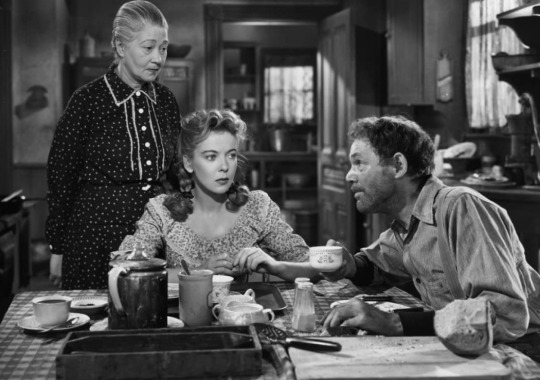
In 1947, Bainter reteamed with Hull as Ida Lupino’s parents in the film Deep Valley. Nearly 25 years after first meeting, Rose and Tony were reunited.
#The Other Rose#Fay Bainter#Henry Hull#George Middleton#1923#Broadway#Broadway Play#Atlantic City#Nixon's Apollo Theatre#David Belasco#Morosco Theatre#romance
2 notes
·
View notes